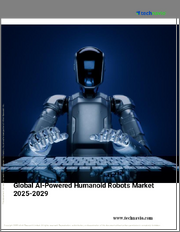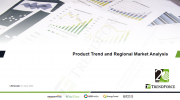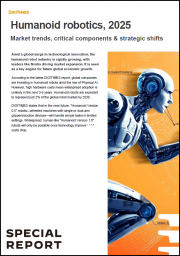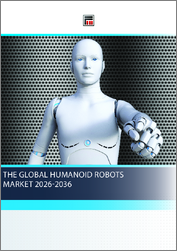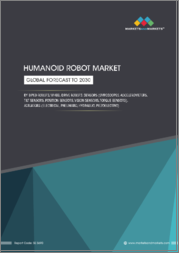
|
시장보고서
상품코드
1494761
휴머노이드 로봇 시장 예측(-2030년) : 유형별, 구성요소별, 용도별, 최종사용자별, 지역별 세계 분석Humanoid Robot Market Forecasts to 2030 - Global Analysis By Type (Bipedal Humanoids, Wheel drive, Androids, Quadrupedal Humanoids and Other Types), Component, Application, End User and By Geography |
||||||
Stratistics MRC에 따르면, 세계 휴머노이드 로봇 시장은 2024년 27억 달러 규모이며, 예측 기간 동안 52.2%의 CAGR로 성장하여 2030년에는 340억 달러에 달할 것으로 예상됩니다.
휴머노이드 로봇은 인간의 외모, 행동, 해부학적 구조를 어느 정도 모방한 로봇을 말합니다. 이 로봇은 일반적으로 머리, 몸통, 팔, 다리 등 인간과 유사한 신체 구조를 가지고 있습니다. 또한 시각, 청각, 촉각과 같은 감각 기능을 갖추고 있어 보다 자연스러운 방식으로 환경 및 인간과 상호 작용할 수 있습니다. 휴머노이드 로봇은 종종 걷기, 물체 잡기, 대화 등 인간의 동작을 모방한 작업이나 기능을 수행하도록 설계되는 경우가 많습니다. 휴머노이드 로봇은 연구, 엔터테인먼트, 교육, 의료, 산업 등 다양한 분야에서 사용되고 있으며, 기술 발전과 인간과 기계의 상호 작용을 개선하는 것을 목표로 하고 있습니다.
자동화에 대한 수요 증가
산업계가 효율적이고 다재다능한 로봇 솔루션에 대한 수요가 증가함에 따라 자동화 수요가 급증하고 있으며, AI 및 로봇 기술의 발전과 함께 인간의 행동을 모방하고 다양한 환경에서 원활하게 상호 작용할 수 있는 휴머노이드 로봇에 대한 선호도가 높아지고 있습니다. 선호도가 높아지고 있습니다. 제조 및 헬스케어에서 고객 서비스 및 엔터테인먼트에 이르기까지 프로세스 간소화, 생산성 향상, 개인화된 경험을 제공하기 위한 자동화에 대한 요구가 시장의 급속한 확장을 주도하고 있습니다.
엄격한 정부 규제
이 시장은 엄격한 정부 규제로 인해 큰 도전에 직면해 있습니다. 이러한 규제는 안전, 프라이버시, 윤리적 사용을 보장하기 위한 것으로, 많은 경우 광범위한 규정 준수 조치가 필요하기 때문에 제조 비용과 시장 출시 시간이 증가합니다. 또한, 여러 지역에 걸친 다양한 규제 프레임워크를 탐색하는 것은 제조업체에게 복잡성과 불확실성을 야기합니다. 이러한 규제는 사회적 수용과 책임감 있는 개발을 위해 매우 중요하지만, 전 세계적으로 휴머노이드 로봇을 혁신하고 상용화하려는 기업에게는 장애물이 될 수 있습니다.
의료 분야의 수요 증가
의료 현장의 고도의 지원 필요성으로 인해 의료 분야의 수요가 급증하고 있습니다. 이러한 휴머노이드 로봇은 환자 관리에서 수술 지원까지 다양한 기능을 제공하여 효율성과 정확성을 향상시킵니다. 재활 지원, 원격의료, 노인 간호 등의 업무에 중점을 두면서 의료 분야의 휴머노이드 로봇에 대한 관심이 크게 증가할 것으로 예상됩니다. 이러한 추세는 의료 서비스 제공에 혁명을 일으키고 진화하는 의료 수요에 대응하는 로봇 공학의 중요성을 강조하고 있습니다.
높은 개발 및 도입 비용
고급 로봇 기술을 개발하기 위해서는 연구, 설계, 제조 공정에 많은 투자가 필요합니다. 또한, 휴머노이드 로봇은 복잡하기 때문에 전문적인 지식이 필요하고, 이는 비용을 더욱 증가시키고 있습니다. 또한, 투자 대비 효과에 대한 우려, 기존 시스템과의 통합 문제, 휴머노이드 로봇의 의미에 대한 사회적 불안감 등으로 인해 시장 도입률이 저조한 상황입니다. 이러한 요인들이 종합적으로 보급을 저해하고 시장 성장을 제한하고 있습니다.
COVID-19의 영향:
COVID-19 사태는 특히 의료, 소매, 접객업 등 분야에서 휴머노이드 로봇에 대한 수요가 급증하는 계기가 되었습니다. 이 로봇들은 소독, 배달, 고객 응대 등의 작업을 지원함으로써 사람과의 접촉을 최소화하고 비접촉식 상호 작용을 제공했습니다. 안전과 효율성에 대한 관심이 높아지면서 기업들은 자동화에 대한 투자를 늘리면서 휴머노이드 로봇 시장의 성장을 촉진했습니다. 팬데믹은 기술 혁신과 채택의 촉매제로 작용하여 휴머노이드 로봇을 COVID 이후 세계에서 필수적인 도구로 자리매김했습니다.
예측 기간 동안 휠 드라이브 분야가 가장 큰 분야가 될 것으로 예상됩니다.
예측 기간 동안 휠 드라이브가 가장 큰 비중을 차지할 것으로 예상됩니다. 이러한 시스템은 로봇의 이동성과 민첩성을 향상시켜 물류, 의료, 서비스 산업 등 다양한 분야에서 로봇의 유용성을 확대할 것입니다. 휠 드라이브 기술은 로봇이 복잡한 환경에서 효율적으로 이동할 수 있도록 하여 작업 성능과 사용자 상호 작용을 향상시키는 데 기여하며, AI 및 센서 기술의 발전과 함께 휠 드라이브의 통합은 시장의 능력과 다재다능함을 더욱 혁신할 준비가 되어 있습니다.
숙박업 부문은 예측 기간 동안 가장 높은 CAGR을 기록할 것으로 예상됩니다.
호스피탈리티 분야는 예측 기간 동안 가장 높은 CAGR을 보일 것으로 예상되며, AI와 자연어 처리 기능이 탑재된 이 로봇은 체크인, 룸서비스, 문의 등을 능숙하게 지원하여 효율성과 고객 경험을 향상시킬 수 있습니다. 인간형 디자인은 친근감과 편안함을 조성하고 학습 및 적응 능력은 개인화 된 상호 작용을 보장합니다. 로봇공학과 AI의 발전으로 이러한 휴머노이드 어시스턴트는 호스피탈리티의 기준을 재정의하고 전 세계 고객에게 원활하고 매력적인 경험을 제공할 준비가 되어 있습니다.
가장 큰 점유율을 차지하는 지역
예측 기간 동안 북미가 가장 큰 시장 점유율을 차지할 것으로 예상됩니다. 헬스케어에서 엔터테인먼트, 제조에 이르기까지 다양한 분야에서 휴머노이드 로봇에 대한 수요가 증가하고 있습니다. 기업들은 자연어 처리, 인간과 같은 움직임 등 로봇의 능력을 향상시키기 위해 연구개발에 투자하고 있습니다. 또한, 첨단 기술 대기업과 스타트업의 협업은 혁신을 촉진하고 이 지역의 다양한 산업에서 시장 확대에 기여하고 있습니다.
CAGR이 가장 높은 지역:
아시아태평양은 로봇 연구개발에 대한 투자 증가, 인건비 상승, 다양한 산업 분야의 자동화 수요 증가 등의 요인으로 인해 예측 기간 동안 가장 높은 CAGR을 유지할 것으로 예상됩니다. 인간형 로봇은 병원에서는 환자 치료를 돕기 위해 학교에서는 학습을 촉진하기 위해 테마파크에서는 엔터테인먼트 목적으로, 소매점에서는 고객 서비스를 위해 공장에서는 조립 및 검사와 같은 작업에 사용됩니다.
무료 맞춤형 서비스:
이 보고서를 구독하는 고객은 다음과 같은 무료 맞춤화 옵션 중 하나를 이용할 수 있습니다.
- 기업 개요
- 추가 시장 기업 종합 프로파일링(최대 3개사까지)
- 주요 기업 SWOT 분석(최대 3개사)
- 지역 세분화
- 고객의 관심에 따른 주요 국가별 시장 추정치, 예측, CAGR(주: 타당성 검토에 따른)
- 경쟁사 벤치마킹
- 제품 포트폴리오, 지리적 입지, 전략적 제휴를 기반으로 한 주요 기업 벤치마킹
목차
제1장 주요 요약
제2장 서문
- 개요
- 이해관계자
- 조사 범위
- 조사 방법
- 데이터 마이닝
- 데이터 분석
- 데이터 검증
- 조사 접근법
- 조사 정보 출처
- 1차 조사 정보 출처
- 2차 조사 정보 출처
- 가정
제3장 시장 동향 분석
- 성장 촉진요인
- 성장 억제요인
- 기회
- 위협
- 용도 분석
- 최종사용자 분석
- 신흥 시장
- COVID-19의 영향
제4장 Porter's Five Forces 분석
- 공급 기업의 교섭력
- 구매자의 교섭력
- 대체품의 위협
- 신규 참여업체의 위협
- 경쟁 기업 간의 경쟁 관계
제5장 세계의 휴머노이드 로봇 시장 : 유형별
- 이족 보행 휴머노이드
- 휠 구동
- 안드로이드
- 사족 보행 휴머노이드
- 기타 유형
제6장 세계의 휴머노이드 로봇 시장 : 컴포넌트별
- 소프트웨어
- 음성 인식
- 감정 분석
- 운영체제
- 이미지 인식
- 하드웨어
- 센서
- 액추에이터
- 모터
- 전력 시스템
- 컨트롤 유닛
제7장 세계의 휴머노이드 로봇 시장 : 용도별
- 퍼스널 어시스턴스와 간병
- 교육과 엔터테인먼트
- 호스피탈리티
- 연구와 우주 탐사
- 수색구조
- 기타 용도
제8장 세계의 휴머노이드 로봇 시장 : 최종사용자별
- 건설
- 헬스케어
- 군·방위
- 해양
- 상업용
- 항공우주
- 기타 최종사용자
제9장 세계의 휴머노이드 로봇 시장 : 지역별
- 북미
- 미국
- 캐나다
- 멕시코
- 유럽
- 독일
- 영국
- 이탈리아
- 프랑스
- 스페인
- 기타 유럽
- 아시아태평양
- 일본
- 중국
- 인도
- 호주
- 뉴질랜드
- 한국
- 기타 아시아태평양
- 남미
- 아르헨티나
- 브라질
- 칠레
- 기타 남미
- 중동 및 아프리카
- 사우디아라비아
- 아랍에미리트
- 카타르
- 남아프리카공화국
- 기타 중동 및 아프리카
제10장 주요 발전
- 계약, 파트너십, 협업, 합작투자
- 인수와 합병
- 신제품 발매
- 사업 확대
- 기타 주요 전략
제11장 기업 개요
- Honda Motor Co., Ltd.
- Hitachi
- Agility Robotics
- Qihan Technology Co
- Samsung Electronics
- Toyota Motor
- Ubtech Robotics
- SoftBank Robotics
- KAWADA Robotics Corp.
- Toshiba Corp.
- Hanson Robotics
- Boston Dynamics
- Mitsubishi Robotics
- Hyundai Robotics
- Yaskawa Electric Corporation
- DST Robot Co.
According to Stratistics MRC, the Global Humanoid Robot Market is accounted for $2.7 billion in 2024 and is expected to reach $34.0 billion by 2030 growing at a CAGR of 52.2% during the forecast period. A humanoid robot is a robot that resembles or imitates human appearance, behavior, or anatomy to some extent. These robots typically have a body structure similar to that of a human, with a head, torso, arms, and legs. They may also feature sensory capabilities such as vision, hearing, and touch, allowing them to interact with the environment and humans in a more natural manner. Humanoid robots are often designed to perform tasks or functions that mimic human actions, such as walking, grasping objects, or engaging in conversation. They are used in various fields, including research, entertainment, education, healthcare, and industry, with the aim of advancing technology and improving human-machine interaction.
Market Dynamics:
Driver:
Rising demand for automation
The market is experiencing a surge in demand for automation as industries increasingly seek efficient and versatile robotic solutions. With advancements in AI and robotics technology, there's a growing preference for humanoid robots capable of mimicking human actions and interacting seamlessly in various environments. From manufacturing and healthcare to customer service and entertainment, the need for automation to streamline processes, enhance productivity, and deliver personalized experiences is driving the rapid expansion of the market.
Restraint:
Stringent government regulations
The market faces significant challenges due to stringent government regulations. These regulations, aimed at ensuring safety, privacy, and ethical use, often require extensive compliance measures, increasing production costs and time-to-market. Moreover, navigating diverse regulatory frameworks across different regions adds complexity and uncertainty for manufacturers. While these regulations are crucial for societal acceptance and responsible development, they pose hurdles for companies aiming to innovate and commercialize humanoid robotics on a global scale.
Opportunity:
Growing demand from the medical sector
The market is experiencing a surge in demand from the medical sector, driven by the need for advanced assistance in healthcare settings. These humanoid robots offer capabilities ranging from patient care to surgery assistance, enhancing efficiency and precision. With an emphasis on tasks like rehabilitation support, telemedicine, and elder care, the medical sector's interest in humanoid robots is projected to grow significantly. This trend underscores the importance of robotics in revolutionizing healthcare delivery and addressing evolving medical needs.
Threat:
High cost of development and adoption
Creating advanced robotic technology requires substantial investment in research, design, and manufacturing processes. Additionally, the complexity of humanoid robots demands specialized expertise, further driving up costs. Furthermore, the market's slow adoption rate stems from concerns about return on investment, integration challenges with existing systems, and societal apprehensions about the implications of humanoid robots. These factors collectively hinder widespread adoption and limit market growth.
Covid-19 Impact:
The COVID-19 pandemic catalyzed a surge in demand for humanoid robots, particularly in sectors like healthcare, retail, and hospitality. These robots offered contactless interactions, aiding in tasks such as disinfection, delivery, and customer service, thus minimizing human-to-human contact. With an increased focus on safety and efficiency, businesses invested more in automation, driving growth in the humanoid robot market. The pandemic acted as a catalyst for technological innovation and adoption, positioning humanoid robots as indispensable tools in a post-COVID world.
The wheel drive segment is expected to be the largest during the forecast period
The wheel drive is expected to be the largest during the forecast period. These systems offer enhanced mobility and agility to robots, expanding their utility across various domains including logistics, healthcare, and service industries. Wheel drive technology enables robots to navigate complex environments efficiently, contributing to improved task performance and user interaction. With advancements in AI and sensor technologies, the integration of wheel drives is poised to further revolutionize the capabilities and versatility of the market.
The hospitality segment is expected to have the highest CAGR during the forecast period
The hospitality segment is expected to have the highest CAGR during the forecast period. These robots, equipped with AI and natural language processing, adeptly assist guests with check-ins, room service, and inquiries, enhancing efficiency and guest experience. Their humanoid design fosters a sense of familiarity and comfort, while their ability to learn and adapt ensures personalized interactions. With advancements in robotics and AI, these humanoid assistants are poised to redefine hospitality standards, offering seamless and engaging experiences for patrons worldwide.
Region with largest share:
North America is projected to hold the largest market share during the forecast period. With applications spanning from healthcare to entertainment and manufacturing, the demand for humanoid robots is on the rise. Companies are investing in research and development to enhance robot capabilities, such as natural language processing and human-like movement. Additionally, collaborations between tech giants and startups are fueling innovation, contributing to the expansion of the market across various industries in the region.
Region with highest CAGR:
Asia Pacific is projected to hold the highest CAGR over the forecast period driven by factors such as increasing investments in robotics research and development, rising labor costs, and growing demand for automation across various industries. Humanoid robots are being used in hospitals to assist with patient care, in schools to facilitate learning, in theme parks for entertainment purposes, in retail stores for customer service, and in factories for tasks such as assembly and inspection.
Key players in the market
Some of the key players in Humanoid Robot market include Honda Motor Co., Ltd., Hitachi, Agility Robotics, Qihan Technology Co, Samsung Electronics, Toyota Motor, Ubtech Robotics, SoftBank Robotics, KAWADA Robotics Corp., Toshiba Corp., Hanson Robotics, Boston Dynamics, Mitsubishi Robotics, Hyundai Robotics, Yaskawa Electric Corporation, and DST Robot Co.
Key Developments:
In March 2023, Agility Robotics launched Next Generation of Digit: World's first human-centric, multi-purpose robot made for logistics work. Digit is designed from the ground up to go where people go and do useful work safely in spaces designed for people, starting with bulk material handling within warehouses and distribution centers.
In March 2023, SoftBank Robotics (Japan) released a new robot app called "Let's Dance!". This app allows users to make the Pepper robot dance using preset popular dance moves or create unique dance routines with a combination of motions.
In September 2022, KAWADA launched NEXTAGE Fillie OPEN, a dual-arm robot. It is part of the NEXTAGE series of humanoid robots and is a research robot platform. The robot is designed for research and development, offering versatility and compatibility with open-source robot middleware (ROS).
Types Covered:
- Bipedal Humanoids
- Wheel drive
- Androids
- Quadrupedal Humanoids
- Other Types
Components Covered:
- Software
- Hardware
Applications Covered:
- Personal Assistance & Caregiving
- Education & Entertainment
- Hospitality
- Research & Space Exploration
- Search & Rescue
- Other Applications
End Users Covered:
- Construction
- Healthcare
- Military & Defense
- Marine
- Commercial
- Aerospace
- Other End Users
Regions Covered:
- North America
- US
- Canada
- Mexico
- Europe
- Germany
- UK
- Italy
- France
- Spain
- Rest of Europe
- Asia Pacific
- Japan
- China
- India
- Australia
- New Zealand
- South Korea
- Rest of Asia Pacific
- South America
- Argentina
- Brazil
- Chile
- Rest of South America
- Middle East & Africa
- Saudi Arabia
- UAE
- Qatar
- South Africa
- Rest of Middle East & Africa
What our report offers:
- Market share assessments for the regional and country-level segments
- Strategic recommendations for the new entrants
- Covers Market data for the years 2022, 2023, 2024, 2026, and 2030
- Market Trends (Drivers, Constraints, Opportunities, Threats, Challenges, Investment Opportunities, and recommendations)
- Strategic recommendations in key business segments based on the market estimations
- Competitive landscaping mapping the key common trends
- Company profiling with detailed strategies, financials, and recent developments
- Supply chain trends mapping the latest technological advancements
Free Customization Offerings:
All the customers of this report will be entitled to receive one of the following free customization options:
- Company Profiling
- Comprehensive profiling of additional market players (up to 3)
- SWOT Analysis of key players (up to 3)
- Regional Segmentation
- Market estimations, Forecasts and CAGR of any prominent country as per the client's interest (Note: Depends on feasibility check)
- Competitive Benchmarking
- Benchmarking of key players based on product portfolio, geographical presence, and strategic alliances
Table of Contents
1 Executive Summary
2 Preface
- 2.1 Abstract
- 2.2 Stake Holders
- 2.3 Research Scope
- 2.4 Research Methodology
- 2.4.1 Data Mining
- 2.4.2 Data Analysis
- 2.4.3 Data Validation
- 2.4.4 Research Approach
- 2.5 Research Sources
- 2.5.1 Primary Research Sources
- 2.5.2 Secondary Research Sources
- 2.5.3 Assumptions
3 Market Trend Analysis
- 3.1 Introduction
- 3.2 Drivers
- 3.3 Restraints
- 3.4 Opportunities
- 3.5 Threats
- 3.6 Application Analysis
- 3.7 End User Analysis
- 3.8 Emerging Markets
- 3.9 Impact of Covid-19
4 Porters Five Force Analysis
- 4.1 Bargaining power of suppliers
- 4.2 Bargaining power of buyers
- 4.3 Threat of substitutes
- 4.4 Threat of new entrants
- 4.5 Competitive rivalry
5 Global Humanoid Robot Market, By Type
- 5.1 Introduction
- 5.2 Bipedal Humanoids
- 5.3 Wheel drive
- 5.4 Androids
- 5.5 Quadrupedal Humanoids
- 5.6 Other Types
6 Global Humanoid Robot Market, By Component
- 6.1 Introduction
- 6.2 Software
- 6.2.1 Speech Recognition
- 6.2.2 Sentiment Analysis
- 6.2.3 Operating System
- 6.2.4 Image Recognition
- 6.3 Hardware
- 6.3.1 Sensors
- 6.3.2 Actuators
- 6.3.3 Motors
- 6.3.4 Power Systems
- 6.3.5 Control Unit
7 Global Humanoid Robot Market, By Application
- 7.1 Introduction
- 7.2 Personal Assistance & Caregiving
- 7.3 Education & Entertainment
- 7.4 Hospitality
- 7.5 Research & Space Exploration
- 7.6 Search & Rescue
- 7.7 Other Applications
8 Global Humanoid Robot Market, By End User
- 8.1 Introduction
- 8.2 Construction
- 8.3 Healthcare
- 8.4 Military & Defense
- 8.5 Marine
- 8.6 Commercial
- 8.7 Aerospace
- 8.8 Other End Users
9 Global Humanoid Robot Market, By Geography
- 9.1 Introduction
- 9.2 North America
- 9.2.1 US
- 9.2.2 Canada
- 9.2.3 Mexico
- 9.3 Europe
- 9.3.1 Germany
- 9.3.2 UK
- 9.3.3 Italy
- 9.3.4 France
- 9.3.5 Spain
- 9.3.6 Rest of Europe
- 9.4 Asia Pacific
- 9.4.1 Japan
- 9.4.2 China
- 9.4.3 India
- 9.4.4 Australia
- 9.4.5 New Zealand
- 9.4.6 South Korea
- 9.4.7 Rest of Asia Pacific
- 9.5 South America
- 9.5.1 Argentina
- 9.5.2 Brazil
- 9.5.3 Chile
- 9.5.4 Rest of South America
- 9.6 Middle East & Africa
- 9.6.1 Saudi Arabia
- 9.6.2 UAE
- 9.6.3 Qatar
- 9.6.4 South Africa
- 9.6.5 Rest of Middle East & Africa
10 Key Developments
- 10.1 Agreements, Partnerships, Collaborations and Joint Ventures
- 10.2 Acquisitions & Mergers
- 10.3 New Product Launch
- 10.4 Expansions
- 10.5 Other Key Strategies
11 Company Profiling
- 11.1 Honda Motor Co., Ltd.
- 11.2 Hitachi
- 11.3 Agility Robotics
- 11.4 Qihan Technology Co
- 11.5 Samsung Electronics
- 11.6 Toyota Motor
- 11.7 Ubtech Robotics
- 11.8 SoftBank Robotics
- 11.9 KAWADA Robotics Corp.
- 11.10 Toshiba Corp.
- 11.11 Hanson Robotics
- 11.12 Boston Dynamics
- 11.13 Mitsubishi Robotics
- 11.14 Hyundai Robotics
- 11.15 Yaskawa Electric Corporation
- 11.16 DST Robot Co.







